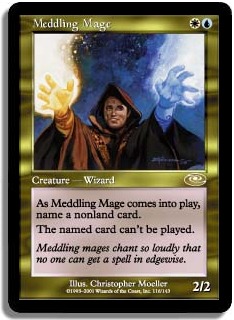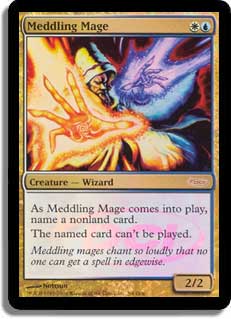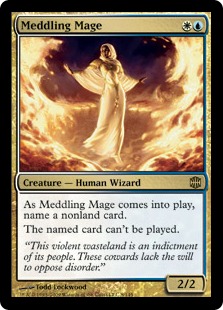Hello everyone, and welcome to my second Ben’s Ten column! This week I’m going to take a look at the ten most disappointing cards in Shards block. These are the cards that started off with a lot of hype, but ended up being major disappointments in Constructed play. Note that this particular list has a bias towards tournament play — I recognize that some of the cards on this list have seen some amount of EDH love, but in the end, their failure to live up to their initial surge in popularity/perceived power level landed them on this list.
A quick side note before I get started: Originally I was going to do a trilogy of Shards top 10 lists before moving on to other pastures: The 10 Best, 10 Worst, and 10 Most Disappointing cards in the block. I developed all three lists at once, and quickly realized that a “10 Worst Cards in Shards Block” list was pretty uninteresting — Wizards has really decreased the amount of pure chaff they release in their sets! So I wanted to give a quick “Hats off!” to Wizards R&D — there’s very few Pale Moons these days, and even the bad cards are not cards that would generally break anywhere near my list of “worst of all time”. In the end, I killed that entire article, thanks to the improved “bottom end” of the bad cards in Shards Block!
With that said, let the festivities begin! As always, feedback/discussion/debate is always appreciated in the forums!
10) Marisi’s Twinclaws
By definition, the majority of cards on this list are going to be Rares and Mythics — he who starts the highest has the greatest distance to fall. There are two Mythics, five Rares, two Uncommons, and one Common on this list. Marisi’s Twinclaws was touted as a big card for Naya decks — effectively a four-toughness, four-power attacker which could really get nasty with the aid of equipment, or Giant Growth/Honor of the Pure-type effects. You can infer that Wizards also thought Marisi’s Twinclaws was going to be a big card, because it was one of their picks to make into a WPN promo.
To borrow a page from LSV, they were less Marisi’s Twinclaws and more Marmissedi’s Twinclaws. Never really saw serious play, didn’t click too much with the casual player, and Naya went in a totally different direction anyhow — the small guys were the beaters, and the large guys helped enable the small guys (see: Bloodbraid Elf, Ranger of Eos, Knight of the Reliquary, Wild Nacatl, Fauna Shaman). If you wanted a Red/White four-drop, you usually just ended up going with Ajani Vengeant.
9) Stoic Angel
Stoic Angel is a homage to Lightning Angel — a 3/4 Angel for XYZ1 (that’s three-different colors of mana plus one colorless, for those following at home) with a special ability. Lightning Angel had Haste and Vigilance, allowing it to get in for quick beats, while still playing defense. Stoic Angel traded Haste for Smoke — players could only untap one creature a turn, while Stoic Angel was on the battlefield. In theory, Vigilance (doesn’t tap to attack) plays well with Smoke (hey look! I never have to untap Stoic Angel!), but in reality the Bant deck never really was a defensive deck — the two most remembered iterations of Bant plowed Exalted effects (Finest Hour, Rafiq of the Many) on top of evasive creatures (Birds of Paradise/Jhessian Infiltrator) or abused the Sovereigns of Lost Alara/Eldrazi Conscription combo (hey look, Ma! I got an 11/12 attacking Noble Hierarch!) — so there was no need for super-defensive Angel. The non-Exalted creatures stayed home, leaving the Bant player with plenty of blockers anyhow. Plus the deck enjoyed killing over the course of two turns — either with a 6/6+ double-striker, or a Conscription-enhanced +10/+10 trampling monster. This was not a deck that played a slow, controlling middle game — and that would have been a game more suited to Stoic Angel.
8) Bloodhall Ooze
Mark Rosewater previewed this card, and likened it to Wild Nacatl (which yes, probably should have been on my list last week instead of Hellspark Elemental — but I defend my choice to leave Elspeth off, as she was played less, and usually as a 1-2 of, than almost any other card on my top 10 list). Players bought into the dream of having a one-drop creature that could grow to an enormous size quickly. They didn’t stop to see the effort it would take to get to this size — you’d need to somehow play a Black/Green permanent on the first turn, alongside Bloodhall Ooze, to have a 3/3 Bloodhall Ooze on turn 2. If you played a turn 1 Ooze and turn 2 Black/Green guy (or vice versa) , you’d still have to wait to turn 3 to have a 3/3 Ooze. There ended up being too much work involved to get a payoff on a 1/1 creature that might end up bigger, and Bloodhall Ooze didn’t stand a chance once variants started showing up in force during Zendikar block — cards like Scute Mob and Dragonmaster Outcast.
7) Lapse of Certainty
The only Common on this list, players thought that with the weakening of Blue (Countermagic was at an all-time lull right after Lorwyn block rotated) would necessitate/allow for the emergence of other Countermagic to reign supreme. Either that, or they thought that a one-turn delay would allow a White Weenie deck to win via a well-timed Lapse of Certainty. White Weenie wasn’t much of a factor, and Blue ended up being a tap-out color for a while (W/U Jace) before M11 (Mana Leak), so Lapse never really had a place in the metagame.
6) Lord of Extinction
The only thing standing between Lord of Extinction and playability was some form of evasion: trample most likely. With trample, Lord of Extinction would have been a reanimation target, or a way to beat through mass-token creation, or something. Without any evasion, Lord of Extinction was a conditional 1/1 to 20/20 dude that could be chump blocked by 3/3 Elephants or 0/1 Eldrazi until your opponent died from boredom.
5) Sen Triplets
While I recognize this is probably the most EDH-friendly card on this list (hi there, EDH people!), Sen Triplets was a dismal failure in Constructed. No card on this list had a bigger monetary fall in value than Sen Triplets (dropping from $10+ area at release, to the $2 range circa now). Of the five Shards, Esper was the least successful — Esper cards showed up in various decks (Tidehollow Sculler, Esper Charm, Tezzeret the Seeker, Ethersworn Canonist), but there was never really an “ESPER” deck that competed in Standard — which was not the case for Jund (Bloodbraid Elf/Blightning/Putrid Leech/Broodmate Dragon/Sprouting Thrinax), Bant (see Stoic Angel, above), Grixis (Cruel Control & Dredge/Extractor Demon builds), or Naya (Boss Naya).
People were wowed by the thoughts of a Mindslaver-a-turn effect on Sen Triplets, but while Mindslaver allows a player to control an opponent’s entire turn, Sen Triplets only lets you play their hand. This is key for things like “forcing your opponent to attack all of their own creatures to death/allow you to alpha strike” or “Tap them out so they can’t cast instants on their turn” or even “hey! Let me make you sacrifice the Fetch Land I just made you play, so you can search for nothing to put into play!” Between the lack of total dominance over an opponent’s turn, the hard-to-cast cost on this guy (again, WYZ in the mana cost) and the lack of a good Esper deck, Sen Triplets was really a let-down to the tournament community.
4) Exotic Orchard
Exotic Orchard is one of the only cards on this list to be a big disappointment due to the hype on another card — in this case Reflecting Pool. Reflecting Pool was one of the hottest cards in Lorwyn/Shadowmoor block, and a staple for decks that wanted to play three+ colors of spell – Five-Color Control with Vivid Lands, for instance. Exotic Orchard was hyped as the Next Big Thing after Reflecting Pool, because it was a reverse-design on Reflecting Pool — instead of any of your own colors, you got any of your opponent’s colors. This would have been great if everyone was a Five-Color on Five-Color mirror, but that was not the case in Standard.
The problem with Exotic Orchard is that it almost never gives you what you want, when you want it. If you’re playing a mono-color (or two-color) deck, you’re almost always better off with any number of other dual-lands to play — so Exotic Orchard is right-out in those decks. If you’re three-to-five colors, Exotic Orchard is a bust if you’re playing someone who is mono-colored (Red Burn/Vampires), and is marginal if they have only two colors for you to choose from (W/U tap-out). Even against three-color decks (Jund/Bant/Naya), Exotic Orchard might not give you the colors you need (if only I could get a third Black for Cruel Ultimatum against Bant!), so yet again it might be a dead card.
People spent a lot of time comparing Exotic Orchard to Reflecting Pool, but in the end the comparison didn’t bear out — and by the time of Shards Block rotation, Exotic Orchard is virtually at bulk-rare prices.
3) Anathemancer
Anathemancer was supposed to be a high-dollar uncommon — it had the pedigree of Price of Progress, could hit an opponent twice, and would even chump-block for a turn in a pinch. While Anathemancer did end up seeing some play, it was virtually absent in a world where everyone was running a ton of non-basic lands. Part of this is to blame on Path to Exile and Oblivion Ring (can’t unearth when you’re not in the graveyard!), but most of it is to blame on Jund — you don’t want to Bloodbraid into Anathemancer, it’s not big enough to complete on its own with the likes of Putrid Leech and Sprouting Thrinax, and seven mana is a lot to pay for a double-dose of pain. Many (including myself) initially saw Anathemancer as a $2-$3 Uncommon. Anathemancer ended up being less than that, for a playset.
2) Battlegrace Angel
Poor Battlegrace Angel. Even before M10 came out, the Bant strategy topped out at Rafiq of the Many/Finest Hour, so there wasn’t room for this five-drop 4/4 flyer that attacked as a 5/5 Lifelink beater. After M10 came out, Battlegrace Angel fell off the map completely, thanks to a little number I like to call Baneslayer Angel. Which would you rather have — a 4/4 flyer that sometimes is a 5/5 Lifelinked attacker, or a 5/5 flyer that always has lifelink, first strike, and oh hey, stops Dragons and Demons as a bonus? It’s not often that the supposed marquee creature in a color is obsolete before the next block even comes out (Baneslayer Angel was, by design, the top dog in Bant), but Battlegrace Angel was barely even on casual and budget player’s maps once Baneslayer hit.
1) Meddling Mage
I debated about whether Meddling Mage or Battlegrace Angel would take the #1 spot on this list, especially since Battlegrace Angel was a new card, while Meddling Mage was a once-proven top-selling, tier-one powerhouse. In the end, there were many reasons why I thought Meddling Mage was the most disappointing card in Shards Block.
a) Once upon a time, Meddling Mage was a staple in Standard, Extended, Legacy, and Vintage. Even after reprinting, Meddling Mage was rarely seen in any of these formats.
b) The price on Meddling Mage quartered since release.
c) White/Blue decks have been Tier 1 since Jace was released, but Meddling Mage is rarely (not never, but rarely) seen in these decks, or the sideboards of these decks.
d) The original Meddling Mage was a card designed by Chris Pikula, as his prize for winning the Magic Invitational. Meddling Mage has now been reprinted twice (once as a judge promo foil, and once in Alara Reborn), and both times Wizards has put new artwork on the card. This time around, Chris Pikula is a Black Woman that can part the red seas of flame.



When you add up A (lack of tournament play) + B (huge drop in price) + C (wasn’t played even in the decks that featured Blue/White) + D (public relations backlash), you end up with the most disappointing card in Shards Block, in this humble author’s opinion.
So that’s it for this week’s Top 10 list, and check out YO! MTG Taps this week, which should feature an interview with yours truly from Joe and Joe (nice meeting you both at Nationals!) in which I give some thoughts about the rising and falling values of cards in Standard and Extended! Feel free to jump into the forums to debate this list, and I’ll see you all next week!
Next Week: The 10 best one-drop creatures of all time!
